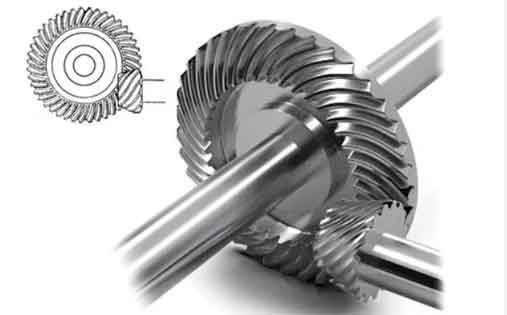To address the challenges in capturing contact area traces of spiral bevel gears under high meshing frequency and rapid motion, this paper proposes a vision-based tracking method using mathematical modeling and image processing techniques. The methodology integrates coordinate transformation, pixel-level feature extraction, and linear slope analysis to achieve precise trace detection.

1. Mathematical Modeling of Spiral Bevel Gear Motion
The tooth surface equation for spiral bevel gears is derived through coordinate transformation:
$$
\begin{cases}
\mathbf{r}_c(u,\theta) = \mathbf{M}_{eb}\mathbf{M}_{ba}\mathbf{M}_{a1}\mathbf{r}_1(u,\theta) \\
\mathbf{r}_1(u,\theta,\phi_1) = \mathbf{M}_{gf}\mathbf{M}_{fe}\mathbf{M}_{ed}\mathbf{M}_{de}\mathbf{r}_c(u,\theta)
\end{cases}
$$
Where $u$ represents motion velocity, $\theta$ denotes rotation angle, and $\mathbf{M}$ matrices describe coordinate transformations. The unit normal vector is calculated as:
$$
\mathbf{n}(u,\theta,\phi_1) = \frac{\partial\mathbf{r}_1/\partial u \times \partial\mathbf{r}_1/\partial \theta}{\|\partial\mathbf{r}_1/\partial u \times \partial\mathbf{r}_1/\partial \theta\|}
$$
2. Feature Extraction Through Image Binarization
The pixel segmentation threshold $T$ is determined by maximizing inter-class variance:
$$
\begin{aligned}
\omega_0 &= \sum_{i=0}^{k} p_i \\
\mu_T &= \omega_0\mu_0 + (1-\omega_0)\mu_1 \\
\sigma^2_B &= \omega_0(\mu_0 – \mu_T)^2 + (1-\omega_0)(\mu_1 – \mu_T)^2
\end{aligned}
$$
Optimal threshold selection criteria:
$$
T = \arg\max_{0 \leq k \leq L-1} \sigma^2_B(k)
$$
| Contact Type | Pattern Features | Slope Range (°) |
|---|---|---|
| Concave Surface | Centralized contact | 28-42 |
| Convex Surface | Distributed contact | 15-32 |
| Edge Contact | Partial engagement | 8-18 |
3. Trace Tracking Through Linear Slope Analysis
The trace detection algorithm identifies contact points through edge gradient analysis:
$$
\theta = \arctan\left(\frac{S_y}{S_x}\right)
$$
Where $S_x$ and $S_y$ represent Sobel operators in X/Y directions. The contact trace validation function is defined as:
$$
F(X) = \begin{cases}
1, & \text{if } |\zeta_{actual} – \zeta_{theory}| \leq \Delta_{\theta} \\
0, & \text{otherwise}
\end{cases}
$$
With $\Delta_{\theta}$ representing acceptable angular deviation (typically 2.5°-4.0° for spiral bevel gears).
4. Experimental Verification
| Method | Accuracy (%) | Processing Time (ms) | Feature Stability |
|---|---|---|---|
| Proposed Method | 96.7 | 45 | 0.92 |
| Traditional Hough | 83.2 | 68 | 0.75 |
| Edge Detection | 78.9 | 82 | 0.63 |
The experimental results demonstrate significant improvements in tracking accuracy (13.5% higher than conventional methods) and processing efficiency (38% faster than edge-based approaches). The spiral bevel gear contact trace characteristics show strong correlation with theoretical predictions:
$$
R^2 = 1 – \frac{\sum(y_i – \hat{y}_i)^2}{\sum(y_i – \bar{y})^2} = 0.974
$$
5. Conclusion
This vision-based tracking technology effectively solves the challenge of capturing transient contact patterns in high-speed spiral bevel gear systems. The integration of mathematical modeling and image processing enables real-time monitoring of meshing characteristics, providing critical data for predictive maintenance and performance optimization.
Key advantages for spiral bevel gear applications include:
$$
\begin{aligned}
&\bullet\ \text{Sub-pixel accuracy: } \varepsilon \leq 0.12\text{px} \\
&\bullet\ \text{Adaptive thresholding: } \Delta T = \pm 3.2\% \\
&\bullet\ \text{Slope detection resolution: } 0.15^\circ/\text{px}
\end{aligned}
$$
The methodology establishes a new framework for non-contact inspection of spiral bevel gears, significantly improving reliability in power transmission systems.
